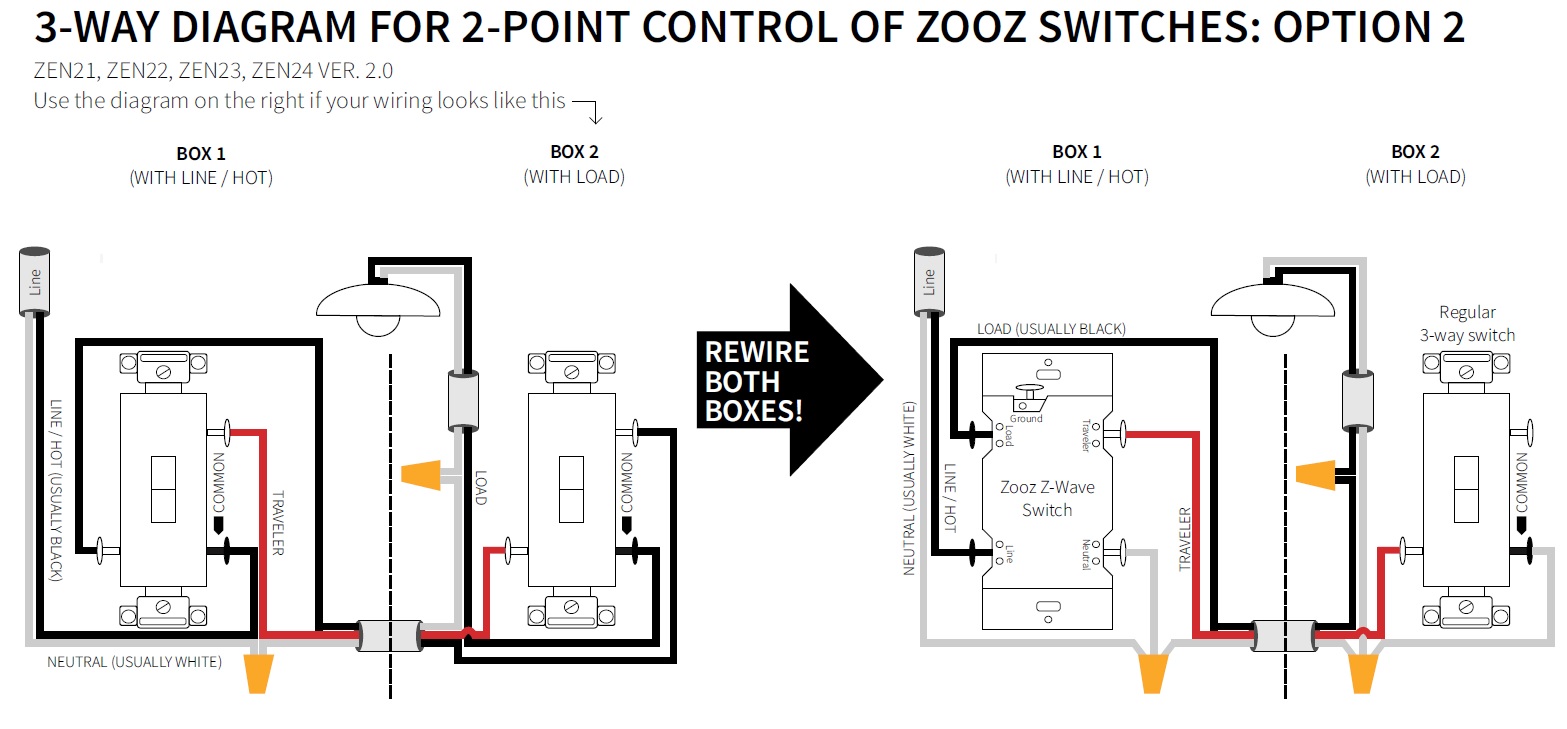See the simplified diagrams below showing 3 different methods of wiring your Zooz 500 series smart switch in a 3-way.
(These are discontinued products, replacement models: ZEN71, ZEN72, ZEN73, ZEN74 - please note that the ZEN73 and ZEN74 toggle switches wire differently in 3-way installation, always follow the instructions for appropriate models when wiring your switches) What does that mean?
Some things to note about the diagrams and installation process:
- These diagrams apply to VER. 2.0 / 3.0 / 4.0 of the following models ONLY: ZEN21, ZEN22, ZEN23, and ZEN24.
- A 3-way is what we call 2-point control so 2 different switches controlling the same set of lights (if you're looking for 3 point control with 3 switches in the install, click here).
- The diagrams show all connections but ground (the ground wire was excluded in order to simplify the illustrations).
- Colors and location of the common screw on the 3-way switches are just for illustration and will not always match your set-up so please don't follow the colors or screw orientation blindly.
- Both boxes need to be rewired.
- The Zooz switch goes into the box with the line in it.
- The 3-way configuration has to have a Zooz switch and a regular on/off 3-way switch at the other end. You won't have the option to dim from the regular 3-way switch. Always use simple on/off 3-way switches when connecting them to Zooz switches. No dimmers or electronic switches with a LED indicator may be wired to Zooz switches or dimmers.
- Zooz doesn't work with any available add-on switches. Unfortunately, we don't have a solution available at the moment that would allow the switches to work with both regular mechanical switches and electronic switches at the same time.
OPTION 1 (Load and line in the same box)
You'll usually see the power line in this box (a bundle of black wires if it's a double or triple box) and the black from your 14-3 romex will be connected to another black (most likely your lights) instead of being connected to the switch. This option can have a few variations depending on the creativity of the electrician who first wired the 3-way. Contact us if you can't match the diagrams exactly.

OPTION 2 (Load and line in separate boxes, the most common set-up)
You'll usually see the black from your 14-3 romex connected directly to the switch on both sides. This can also be wired using different parts of the 14-3 as traveler so if the diagrams almost match but not quite, please don't experiment, contact us first.

OPTION 3 (You'll need to look inside of the fixture box)
If you're positive that you have the power and neutral coming into one of the boxes, and that the black from the 14-3 romex is connected directly to the switch in that box but you only have one black wire coming into the other box, you're probably dealing with a pretty creative set-up that will also require you to open the fixture box and rewire it according to the diagram below. Again, if you're not sure this is the wiring you're dealing with (it's pretty uncommon), contact us to verify before attempting the installation.

There are a few different scenarios that may match your set-up better but they all include a situation where the power line (also called power source or line) is located by the light and not in any of the switch boxes. This is bad news because Zooz switches need direct connection to power and neutral to work. If you can't bring power and neutral to one of the boxes, you won't be able to use Zooz or most other Z-Wave in-wall switches.
If you're unsure about the wiring process or are unable to match your wiring to the provided diagrams, please don't proceed with the installation. Take images of your installation (click here for instructions to get it right the first time) and reach out to us if you have any questions or experience any issues. That's what our team is here for, after all!



